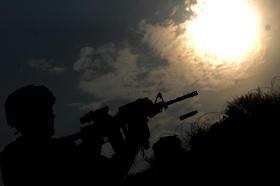At 0420 local time, two long bursts of RPD machine gun fire echoed through the valley at Wanat. Immediately after this signal, insurgents opened up with intense and continuous volleys of machine gun and rocket-propelled grenade (RPG) fire from hidden locations on all sides of the American/ANA position. This initial volley started an intense firefight that lasted for over three and a half hours. For the most part, the battle of Wanat was primarily a contest to obtain and maintain fire superiority with each side laying down intense fire. The AAF fire, particularly the opening salvo, was accurate and came equally from nearby positions within the village of Wanat and the surrounding hillsides. Firing locations in the village itself included the mosque, hotel, and bazaar buildings, all of which were within several yards of the American perimeter.
Army historians have just issued a rare — for them — contemporary history of a battle in a war that the U.S. is still fighting. In Wanat — Combat Action in Afghanistan, 2008, the Army’s Combat Studies Institute dissects the battle that cost nine U.S. troops their lives. It posted the 257-page study on Veterans Day. Brig. General Sean McFarland, deputy commandant at the Command and General Staff College at Fort Leavenworth, Kan., says the study “does not seek to draw final conclusions or to second guess decisions made before or during the heat of battle. Rather, it is an implement of learning, allowing the reader to see the events of that day through the eyes of the leaders and Soldiers of Task Force Rock.” It’s a gripping, inspiring and infuriating read; the bullets start flying on page 141.
The Army issued likely career-ending letters of reprimand to three officers for the inadequate defense of the isolated outpost at Wanat. But that punishment was revoked this past June after additional investigation. David Brostrom, whose son Jonathan was killed during the attack, said he and members of other families walked out of an Army briefing detailing the reversal because they were so upset. “I’ve never seen anything like it,” Brostrom, a former Army colonel who retired from military service in 2004, told the AP at the time. “The Army has reinforced leadership failure.”
McFarland notes in his foreword to the study that “despite the initial advantage of tactical surprise and numerical superiority, it was the insurgents who ultimately broke contact and withdrew…” after the July 13, 2008, battle. But as Paul Harvey used to say, you have to reach page 180 of the report for the rest of the story:
Early on the morning of 15 July [2008], instructions came down from CJTF-101 through TF Bayonet to TF Rock to evacuate Wanat. The American force there immediately began the process of withdrawal. Helicopters began arriving and trucks began pouring in from Camp Blessing. The retrograde movement was executed as rapidly as transportation assets could be moved to Wanat and supplies could be loaded. Unlike the limitations during the establishment of [Wanat], there were plentiful resources available for the withdrawal. The final helicopter flight, which departed in the early morning of 15 July, contained the seven remaining C Company mortarmen and their mortars. With all of the Americans having returned safely to their respective original bases, only a few partially destroyed fighting positions remained…



